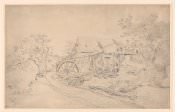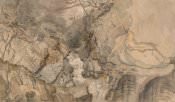James Ward
James Ward
James Ward was born in London and apprenticed at age twelve to the engraver John Raphael Smith. He soon became known as a talented engraver, especially in mezzotint. However, in order to seek admission to the Royal Academy, Ward began to pursue a career as a painter. He initially founded his reputation on rustic genre scenes characterized by loose brushwork and simplified forms; this approach was informed by the painting style of his brother-in-law George Morland and drew on observations made during a trip to Wales. In 1794, Ward was appointed painter and engraver in mezzotint to the Prince of Wales. However, after the turn of century he absorbed the influence of Peter Paul Rubens and adopted a more dramatic style featuring bolder forms and intense colors while continuing his study of human and animal anatomy. As a mature artist he was much in demand for his closely-observed portraits of horses. Livestock and other animals consistently appeared in his work, although he became preoccupied with religious subjects towards from the late 1830s onward and lived the final years of his life in financially perilous state due to a career-ending stroke in 1852.


